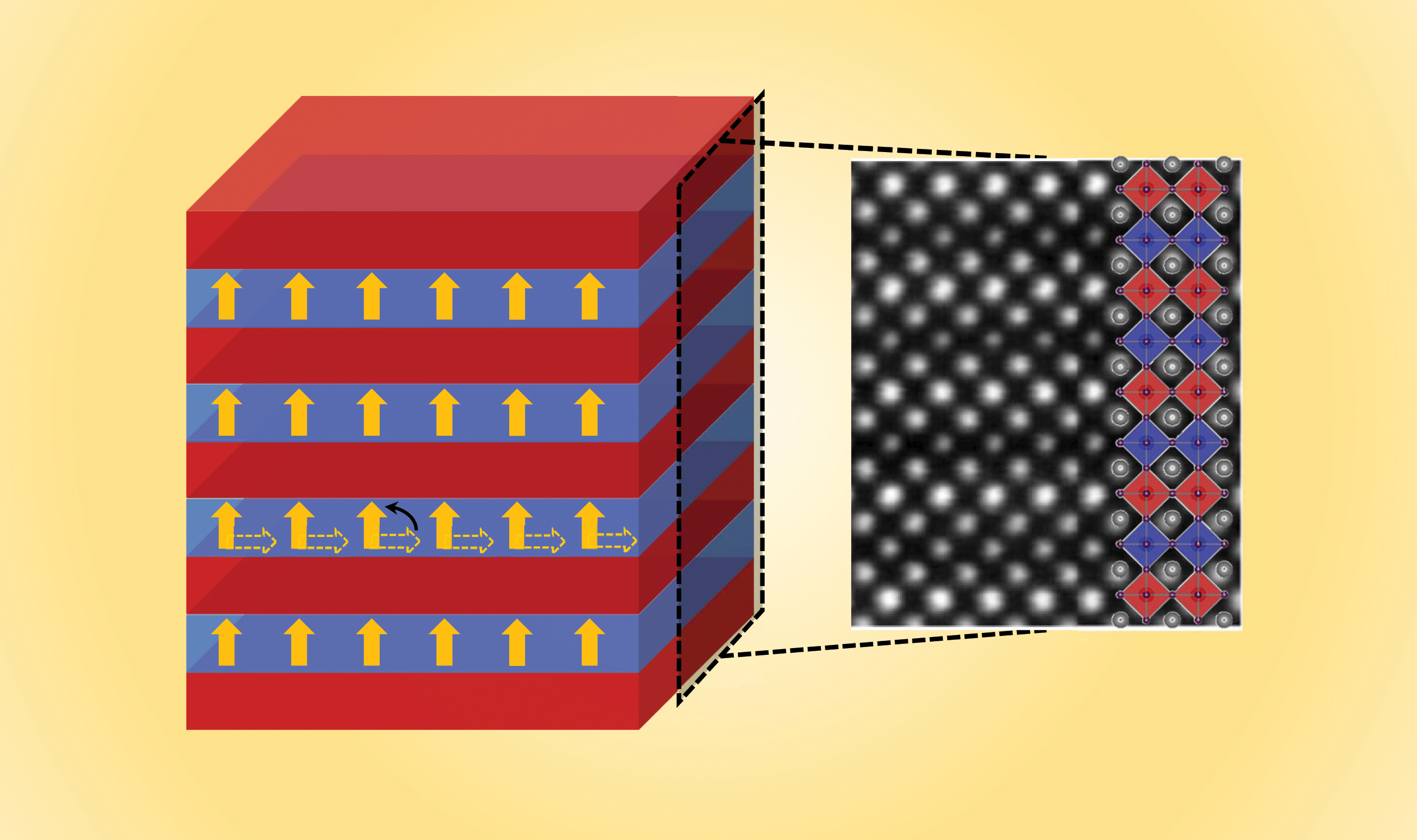By stacking thin films in different ways, scientists can create novel materials that exhibit interesting and potentially useful emergent phenomena. For example, getting the magnetic moments at the surface of a layer to preferentially point out of the layer—i.e., generating perpendicular magnetic anisotropy (PMA)—is of particular interest for high-density, low-power spintronic applications. At several U.S. lightsources, including the ALS, researchers used a powerful combination of hard and soft x-ray techniques to demonstrate how to generate and tune interfacial PMA within superlattices of alternating layers of transition-metal oxides (TMOs). In addition to its practical applications, the work also provides fundamental insight into the factors that drive the emergence of novel functionalities in engineered materials.

Perovskite TMOs are materials of the form ABO3, where A and B are transition-metal ions, with the B ions centered in octahedral “cages” formed by oxygen (O) ions. Magnetic interactions in these materials are dictated largely by the B-O bond distances and angles. Thus, previous demonstrations of PMA in TMO films were achieved by the application of epitaxial strain, resulting in octahedral deformation—a vertical stretching of the oxygen cages.
In this work, the researchers studied superlattices of alternating manganite and iridate TMOs: La1‑xSrxMnO3 (LSMO) and SrIrO3 (SIO). LSMO exhibits magnetic phases ranging from ferromagnetism to antiferromagentism as a function of x. For this study, x was chosen to be 0, 0.3, 0.5, 0.8, and 1. SIO is a paramagnetic metal with strong spin-orbit coupling. Using state-of-art synthesis techniques, the researchers were able to fabricate superlattices with unit-cell precision.
Measurements of the magnetization in the LSMO/SIO superlattices revealed two unexpected results. First, all the superlattices, regardless of x value, exhibited ferromagnetism despite the fact that LSMO is antiferromagnetic for x > 0.5. Second, the superlattices displayed a significant interface-driven PMA, with the strength of the PMA dependent on x.
At ALS Beamline 4.0.2, the researchers explored further by performing x-ray absorption spectroscopy (XAS) measurements at the Mn L-edges. By analyzing the XAS spectra of multiple superlattice and reference films, the researchers discovered a charge transfer of electrons from Ir to Mn orbitals at the interfaces, leading to emergent interfacial ferromagnetism. They also conducted x-ray magnetic circular dichroism (XMCD) measurements at the Mn L-edges at Beamlines 4.0.2 and 6.3.1. Combined with XMCD spectra at the Ir L-edges acquired at the Advanced Photon Source (APS), the researchers determined that the magnetic moments are mostly attributed to LSMO, with a weaker contribution from SIO.
To understand the origin of the PMA and its evolution as a function of x, a comprehensive probe into the local structural distortions was essential. Therefore, the researchers performed x-ray linear dichroism (XLD) measurements at Beamline 4.0.2 to characterize octahedral deformations in the superlattices, but no correlation with the PMA was found. On the other hand, x-ray diffraction measurements conducted at Stanford Synchrotron Radiation Lightsource (SSRL) did reveal that the x-dependence of oxygen octahedral rotation was consistent with the x-dependence of Keff, a measure of PMA strength. Therefore, octahedral rotation (i.e. the interfacial Ir-O-Mn bond angle), rather than octahedral deformation, was identified as the dominant parameter for tuning the PMA.
Taking advantage of the ALS and other synchrotron facilities, the researchers not only discovered a new emergent phenomenon, they also developed a comprehensive understanding of the complex interplay between charge, spin, orbital, and lattice degrees of freedom behind such phenomena. A new strategy for controlling the PMA based on this study can potentially be extended to a wider class of materials. Tunable interfacial PMA, combined with broken inversion symmetry and spin-orbit coupling, are promising model systems in which to search for emergent magnetic textures and topological phenomena in TMOs.

Contact: Di Yi
Research conducted by: D. Yi, C.L. Flint, P.P. Balakrishnan, A. Vailionis, and Y. Suzuki (Stanford University); K. Mahalingam, B. Urwin, and B.M. Howe (Air Force Research Laboratory); A.T. N’Diaye, P. Shafer, and E. Arenholz (ALS); Y. Choi (Argonne National Laboratory); K.H. Stone (SLAC National Accelerator Laboratory); J.-H. Chu and I.R. Fisher (Stanford Univeristy and SLAC); and J. Liu (University of Tennessee).
Research funding: Air Force Office of Scientific Research, Office of Naval Research, National Science Foundation, University of Tennessee, and U.S. Department of Energy, Office of Science, Basic Energy Sciences Program (DOE BES). Operation of the ALS is supported by DOE BES.
Publication about this research: D. Yi, C.L. Flint, P.P. Balakrishnan, K. Mahalingam, B. Urwin, A. Vailionis, A.T. N’Diaye, P. Shafer, E. Arenholz, Y. Choi, K.H. Stone, J.-H. Chu, B.M. Howe, J. Liu, I.R. Fisher, and Y. Suzuki, “Tuning Perpendicular Magnetic Anisotropy by Oxygen Octahedral Rotations in (La1-xSrxMnO3)/(SrIrO3) Superlattices,” Phys. Rev. Lett. 119, 077201 (2017). doi:10.1103/PhysRevLett.119.077201
ALS SCIENCE HIGHLIGHT #365